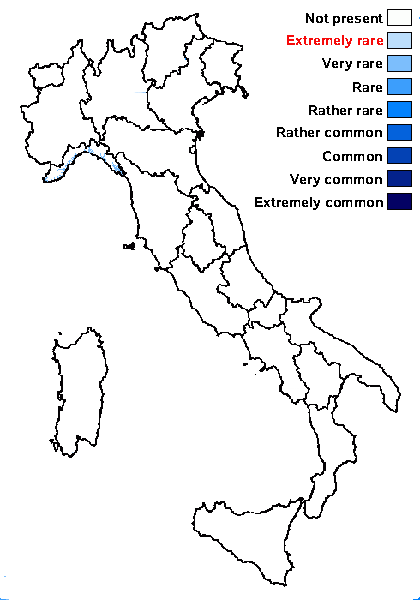Verrucaria rufofuscella Servít
Stud. Bot. Cech., 11: 21, 1950.
Synonyms:
Distribution: N - Lig.
Description: Thallus crustose, episubstratic, dull dark brown to reddish brown, rimose-areolate, 0.20-0.35 mm thick, thinner and broken up into smaller dispersed areoles in peripheral parts, sometimes delimited by a pale prothallus, the areoles irregularly roundish-angular, flat, 0.3-0.7(-1) mm wide, with partly subascending and finely crenulated margins. Cortex poorly developed, pale brown in uppermost part, sometimes overlain by a very thin epinecral layer; algal layer irregular, inspersed with crystals; medulla white to pale brown, with substrate particles, without a black basal layer. Perithecia black, 1(-3) per areole, largely immersed but the apical part projecting, naked. Involucrellum adpressed to exciple, extending to base-level and more or less incurved beneath exciple, apically and laterally 30-40 µm thick, thinning at base; exciple subglobose, 0.25-0.4 mm across, the wall 15-25 µm thick, black in upper part, paler in basal part; hamathecium of mostly simple, 20-30 µm long periphyses and periphysoids, interascal filaments absent; hymenial gel hemiamyloid, I+ red (I+ blue at very low concentrations of I), K/I+ blue. Asci 8-spored, clavate, I-, fissitunicate, the wall thickened above, with an ocular chamber, dehiscent by extrusion of an endotunica to form a delicate rostrum, Verrucaria-type. Ascospores 1-celled, hyaline, ellipsoid, 20-25 x 11-13 µm. Photobiont chlorococcoid. Spot tests: K-, C-, KC-, P-, UV-. Chemistry: without lichen substances.
Note: a long-forgotten species of siliceous rocks, described from Germany and recently resurrected in the 3rd volume of the Lichen Flora of the Greater Sonoran Region (Nash & al. 2007), where it is reported from southwestern North America, with a good description. In overall appearance it resembles V. fuscoatroides, which mainly differs in having a considerably thicker involucrellum.
Growth form: Crustose
Substrata: rocks
Photobiont: green algae other than Trentepohlia
Reproductive strategy: mainly sexual
Poorly known taxon in need of further study
Commonnes-rarity: (info)
Alpine belt: absent
Subalpine belt: absent
Oromediterranean belt: absent
Montane belt: absent
Submediterranean belt: absent
Padanian area: absent
Humid submediterranean belt: absent
Humid mediterranean belt: very rare
Dry mediterranean belt: absent

Predictive model
Growth form: Crustose
Substrata: rocks
Photobiont: green algae other than Trentepohlia
Reproductive strategy: mainly sexual
Poorly known taxon in need of further study
Commonnes-rarity: (info)
Alpine belt: absent
Subalpine belt: absent
Oromediterranean belt: absent
Montane belt: absent
Submediterranean belt: absent
Padanian area: absent
Humid submediterranean belt: absent
Humid mediterranean belt: very rare
Dry mediterranean belt: absent

Predictive model
 Index Fungorum
Index Fungorum
 GBIF
GBIF


